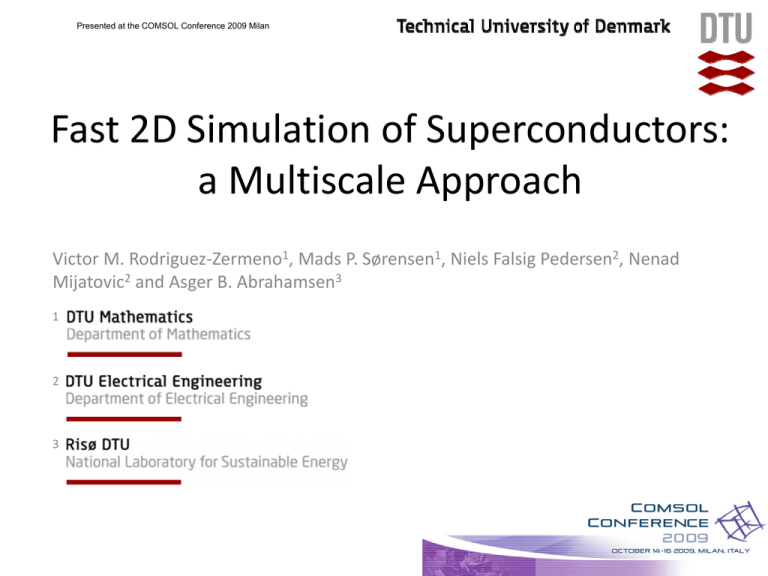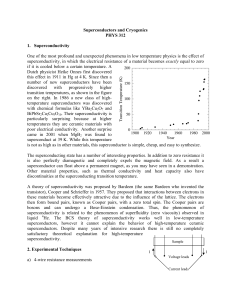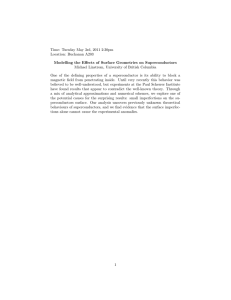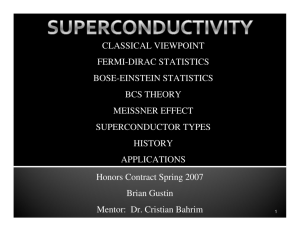Fast 2D Simulation of Superconductors: a Multiscale
advertisement

Presented at the COMSOL Conference 2009 Milan Fast 2D Simulation of Superconductors: a Multiscale Approach Victor M. Rodriguez‐Zermeno1, Mads P. Sørensen1, Niels Falsig Pedersen2, Nenad Mijatovic2 and Asger B. Abrahamsen3 1 2 3 Motivation PhD Project: Computation of Superconducting Wind Turbine Generators. Wire architecture 4.5 mm 0.2 mm Stabilizer coating Substrate Superconducting layer ~ 1 μm Solder Governing equation E‐J relationship in Superconductors E / Ec 1.5 1.0 0.5 0.0 00 0.0 05 0.5 10 1.0 J5 / Jc 11.5 Use of COMSOL Conditions and Restrictions Using Free Meshes 17150 elements in the Superconducting region Using Mapped Meshes Only 150 elements! Calculation of AC losses Results Validation of Results * R. Brambilla et al 2008 Supercond. Sci. Technol. 21 105008 (8pp) Computing Time * R. Brambilla et al 2008 Supercond. Sci. Technol. 21 105008 (8pp) Externally applied field and current Magnetic Field Intensity (peak value shown) for a thin superconductor when a sinusoidal Magnetic Field of 2 mT T (~1.6e3 ( 1 6 3 A/m) A/ ) is i applied li d . No external current applied. External current applied (80% critical current). Interaction among several thin conductors Top: Silver, no external current. Center: superconducting, imposed AC transport current ((0.9 Ic,, 50 Hz). ) Bottom: superconducting, p g, no external transport p current. Notice how the field is expelled from the bottom conductor. Stack of tapes AC electric currents (0.9 (0 9 Ic, Ic 50 Hz, Hz in phase) are applied to a stack of 15 coated conductors. Magnetic field strength at 0 phase (left) and at peak value (right). A substrate with a relative permeability of 50 was considered. The insert shows the thickness of the different layers. AC losses in a stack of tapes Instantaneous AC losses in the previous stack of tapes (both phases are shown in the insert). Consider tapes to be enumerated from the top. Observe that the higher losses are experienced by the central conductors. Also, notice that the top conductors (tapes 1, 2 and d 3) experience i l less l loss than h their h i bottom b counterparts (tapes ( 15, 14 and d 13). 3) Conclusions Use mapped meshes and specifically, use of large aspect ratio elements, provides a considerable increase in the computing speed for calculation of AC losses in superconductors. p Numerical simulations were p performed showing a decrease of 2 to 3 orders of magnitude in the computing time when compared with other 2D simulation were no mapped meshes are used. The time Th ti spentt modeling d li every single i l application li ti while hil using i l large aspectt ratio elements does not depend heavily in the number of conductors and offers “similar” computing time than the 1D formulation. Therefore, the work presented here offers a faster time to solution strategy for calculating AC losses. losses Finally, the ease to set a problem using the proposed formulation makes it possible to think of further applications such as superconducting coils, and induction machinery, y, among g others in the near future. Thank You! References 1. Superconductor, American. Superconductor Motors & Generators. [Online] [Cited: September 1, 2009.] http://www.amsc.com/products/motorsgenerators/index.html. 2. 5 MW High Temperature Superconductor Ship Propulsion Motor Design and Test Results. Eckels, P. W., Snitchler, G. Naval Engineers Journal, Vol. 117, No. 4. (2005), pp. 31-36. 3. Basic concepts, status, opportunities, and challenges of electrical machines utilizing high-temperature superconducting (HTS) windings. J Frauenhofer, J Grundmann, G Klaus and W Nick. 2008, 8th European Conference on Applied Superconductivity (EUCAS 2007) J. Phys.: Conf. Ser. 97 012189. 4. Numerical analysis of high-temperature superconductors with the critical-state model. Farinon, S. Fabbricatore, P. Gomory, F. Greco, M. S il E Seiler, E. IEEE Transactions T i on Applied A li d Superconductivity S d i i June J 2005, 2005 Volume: V l 15, 15 Issue: I 2, 2 Part P 3, 3 pages: 28672867 2870. 2870 5. "Numerical Evaluation of AC Losses in HTS Wires With 2D FEM Formulated by Self Magnetic Field". Kazuhiro Kajikawa, Toshihiro Hayashi, Ryoji Yoshida, Masataka Iwakuma, and Kazuo Funaki,. IEEE TRANS. ON APPLIED SUPERCONDUCTIVITY, VOL. 13, NO. 2, JUNE 2003. 6. AC losses in high-temperature superconductors: revisiting the fundamentals of the loss modelling. Lahtinen, Jaakko Paasi and Markku. Physica C: Superconductivity Volume 310, Issues 1-4, December 1998, Pages 57-61. 7. Numerical modelings of superconducting wires for AC loss calculations. Naoyuki Amemiya, Shun-ichi Murasawa, Nobuya Banno and Kengo Miyamoto. Physica C: Superconductivity Volume 310, Issues 1-4, December 1998, Pages 16-29. 8. “Development of an edge-element model for AC loss computation of high-temperature superconductors”. R. Brambilla, F. Grilli, and L. Martini. Superconductor Science and Technology, vol. 20, pp. 16–24, 2007. 9. ACDC Module/Model Library/Superconducting wire. FILES, COMSOL DOCUMENTATION. 10. Integral g equations q ffor the current densityy in thin conductors and their solution byy the ffinite-element method. Roberto Brambilla,, Francesco Grilli, Luciano Martini and Frédéric Sirois. Superconductor Science and Technology (2008) Volume 21, Number 10.





